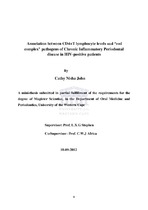| dc.description.abstract | Background: Infection with HIV results in gradual loss of immunologic functions, especially those mediated by CD4+T helper cells with consequent impairment of the immune response leading to severe manifestations of periodontal disease. The lower the CD4+T lymphocyte cell count or the higher the level of immunosuppression, the higher the incidence of periodontal disease in those patients will be. Putative periodontopathic bacteria namely Porphyromonas gingivalis, Treponema denticola and Tannerella forsythia, commonly referred to as "red complex", and many other bacterial species have been implicated in the initiation and progression of periodontal disease. Objective: The present study tests the association between different CD4+T lymphocyte levels and "red complex" pathogens using BANA, in HIV-positive patients with chronic inflammatory periodontal disease (CIPD). Methods: 120 HIV-positive patients from the infectious disease clinic at Tygerberg hospital participated in the study with a mean age of 33.3 years. The CD4+T lymphocyte counts were obtained from patient's medical records. The six Ramjford teeth were used for evaluating periodontal clinical parameters such as plaque index, gingival index, periodontal probing depth and clinical attachment loss. Subgingival plaque samples were collected and analyzed by the enzymatic BANA test for the detection of the "red complex". Results: The CD4+T lymphocyte mean level was 293.43cells/mm3. Statistically significant associations were found between CD4+T cell counts and probing depth (p= 0.0434) and clinical attachment loss (p= 0.0268). Significant associations were found between BANA with all the clinical indices (p= <0.05). However no association was found between CD4+T cell counts and BANA. Conclusion: HIV-positive patients show a high prevalence of "red complex" pathogens subgingivally. Immunosuppression seems to favour the colonization of these species, resulting in periodontal disease manifestations. | en_US |

